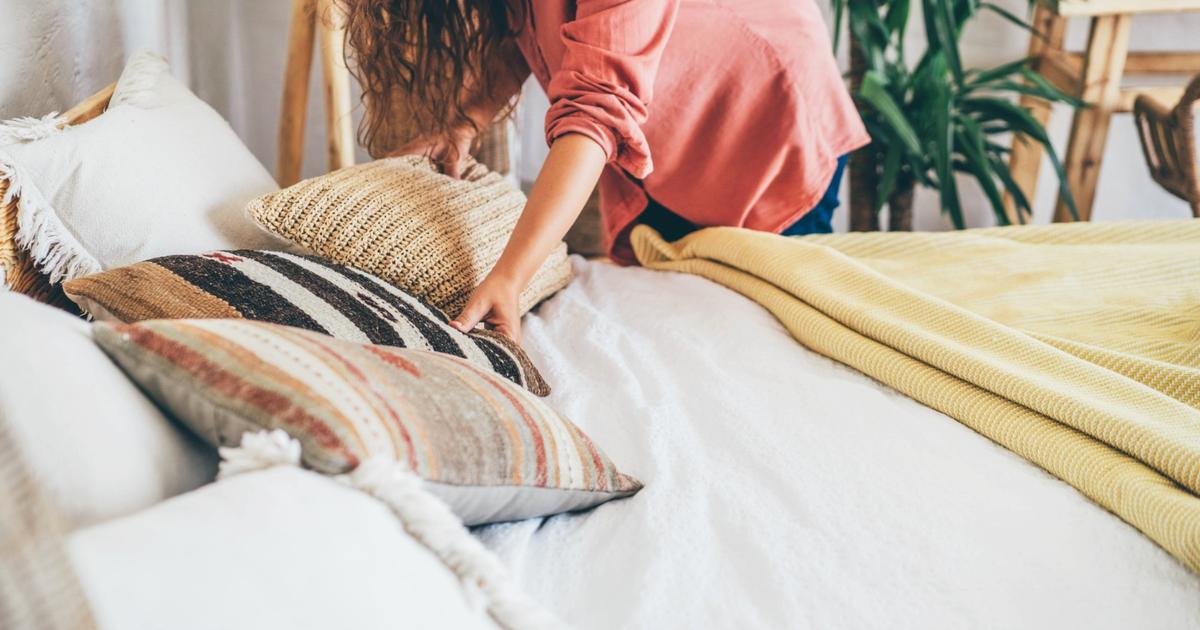When you get out of bed, everyone has their own little ritual.
Some drink a large glass of water, others stretch, while the more maniacal replace the duvet, fold it meticulously on each side, and smooth the top with the flat of the hand.
As satisfying and commendable as it is, this reflex would not be hygienic.
In any case, this is what several influencers recently said on the TikTok social network.
Verification with an infectious disease doctor and an allergist.
Read alsoHere is the ideal duration of sleep to protect your brain from the age of 40
A pest trap
"If you make your bed as soon as you get up, you're actually trapping millions of dust mites," says @sherifelsahly in a video that has been viewed over 2.7 million times.
Stéphane Gayet, infectious disease specialist and hygienist at the Strasbourg University Hospital, confirms this.
Dust mites, bedbugs or microscopic fungi proliferate in contact with heat and humidity.
"By locking them under the quilt when they wake up, in an environment at body temperature, with residues of perspiration and dead skin, we give them enough to eat and develop better," explains the doctor.
After the disgust felt, a question arises: what risks do we run in living with these micro-organisms?
Contact with dust mites (present at 90% in house dust) first of all represents more of a threat to the body because it causes an allergic reaction in some individuals.
“A genetic predisposition favors the production of IgE antibodies (immunoglobulin E) at the origin of the development of an allergy.
In contact with the allergen – present in particular in the mite – rhinitis, an asthma attack, conjunctivitis or even atopic eczema, can be triggered according to the profiles”, specifies Catherine Quéquet, doctor allergist (1).
In video, eight gestures to adopt to take good care of your bed linen
Ventilate and wash well
No offense to Marie Kondo and consorts, leaving your bed unmade therefore contributes to avoiding these inconveniences.
“By leaving the bed wide open and airing the bedroom for at least 20 to 30 minutes, the ventilation will scare away a good part of these parasites”, assures infectious disease specialist Stéphane Gayet.
The ideal, according to the specialist, is to completely remove the duvet from the bed and extend it outside, or if necessary, on a rack inside.
Extra rinse
However, it is not enough to ventilate to claim victory, nuance Dr. Catherine Quéquet.
"Although they disappear, dust mites leave behind invisible droppings to the naked eye that contain the allergens," she explains.
To get rid of it, specialists recommend washing your bed linen at 60°C, every two weeks, preferably with an unscented detergent so as not to multiply allergens.
“You shouldn't hesitate to use the washing machine's 'extra rinse' function, because even if the high temperature kills the dust mite, it's the prolonged stirring that will eliminate its droppings,” adds Stéphane Gayet.
Daily rules
The fabric composition of the bedding should also not be neglected.
The allergist doctor advises to favor synthetic materials for the pillow, duvet and mattress.
“To clean the latter, avoid the steam and instead carefully vacuum the hose two to three times a month.
In the event of an allergy, we will redouble our precautions by adding an airtight “anti-mite” cover, and not a simple mattress pad, on the mattress and the pillow”, informs Catherine Quéquet.
“Cotton, linen, hemp, wool… Vegetable and natural fibers are more attractive to dust mites, specifies Stéphane Gayet.
We will find much less of it on a synthetic textile, like polyester or polyamide.
Other simple reflexes contribute to not “putting a coin back in the machine”.
"We avoid eating in bed or having an animal climb on it, because their dirt feeds dust mites", points out Dr. Catherine Quéquet.
Finally, in the event of a recurrent allergy or major asthma attacks, the allergist can call in, on medical prescription, an indoor environment adviser who will take samples and analyze the quality of the habitat.
(1) Dr Catherine Quéquet is the author of
Les Nouvelles Allergies
, published by Éditions du Rocher, 280 pages, €19.90.








